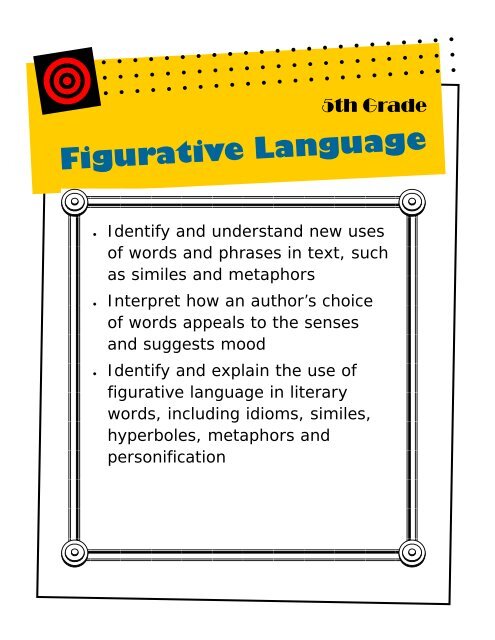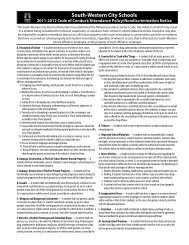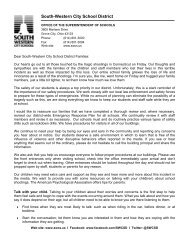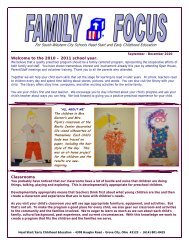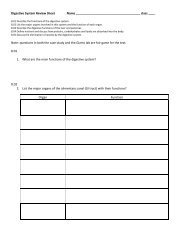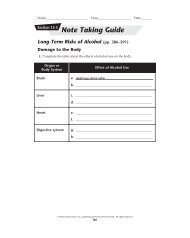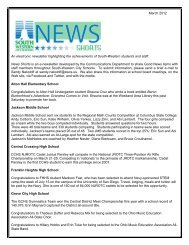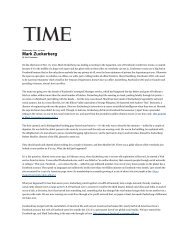5th - figurative language
5th - figurative language
5th - figurative language
You also want an ePaper? Increase the reach of your titles
YUMPU automatically turns print PDFs into web optimized ePapers that Google loves.
<strong>5th</strong> Grade<br />
Figurative Language<br />
• Identify and understand new uses<br />
of words and phrases in text, such<br />
as similes and metaphors<br />
• Interpret how an author’s choice<br />
of words appeals to the senses<br />
and suggests mood<br />
• Identify and explain the use of<br />
<strong>figurative</strong> <strong>language</strong> in literary<br />
words, including idioms, similes,<br />
hyperboles, metaphors and<br />
personification
What Students Need to Know:<br />
• <strong>figurative</strong> <strong>language</strong><br />
• idioms<br />
• similes<br />
• hyperboles<br />
• metaphors<br />
• personification<br />
• author’s choice of words<br />
• mood<br />
What Students Need to be<br />
Able to Do:<br />
• identify (new uses of words)<br />
• understand (new uses of words)<br />
• interpret (author’s choice of words<br />
appeals to senses and suggests<br />
mood)<br />
• identify (use of <strong>figurative</strong> <strong>language</strong>)<br />
• explain (<strong>figurative</strong> <strong>language</strong>)<br />
Important Vocabulary<br />
Figurative <strong>language</strong>— <strong>language</strong> enriched by word images and figures of speech<br />
Hyperbole—A figure of speech which uses a deliberate exaggeration (e.g., I have told<br />
you a million times.)<br />
Idiom—A combination of words that is not strictly in accordance with grammatical rules<br />
and often possesses a meaning other than its grammatical or logical one (e.g.,<br />
an easy test might be described as a piece of cake)<br />
Metaphor—A figure of speech in which an implied comparison is made between two<br />
unlike things (e.g., he’s a tiger).<br />
Mood—The feeling or atmosphere that a writer creates for a reader; a reflection of an<br />
author’s attitude toward a subject or theme<br />
Personification—A figure of speech in which human qualities are attributed to animals,<br />
inanimate objects or ideas (e.g., happy house)<br />
Simile—A figure of speech in which a comparison is made between two unlike things<br />
using the words “like” or “as” (e.g., she’s as sly as a fox).
Figurative Language<br />
Figurative Speech/Language comes in many forms:<br />
• Simile (Comparisons often with as or like): As smooth as silk, as fast as the wind.<br />
Quick like a lightning bolt.<br />
• Metaphor (Implicit comparison without like or as): You're such an airhead. It's bursting<br />
with flavor.<br />
• Hyperbole (Exaggerating statement): In order to get my assignment done, I'll have to<br />
burn the midnight oil.<br />
• Personification (Giving something a human quality): The sun smiled down on<br />
me...The leaves danced in the wind.<br />
• Idiom (An everyday saying that doesn’t exactly mean what the words say): It’s raining<br />
cats and dogs. He’s a backseat driver.<br />
As a teacher, take time to teach the meanings of <strong>figurative</strong> <strong>language</strong>. Let the students<br />
brainstorm possible sayings for <strong>figurative</strong> <strong>language</strong>. Take a look at the list below and have<br />
students brainstorm a context for which the phrases could be used. For instance: When I<br />
want to use “Bells and whistles,” I could be referring to the new computer I just bought<br />
which has lots of memory, a dvd burner, an amazing video card, a wireless keyboard and<br />
a mouse. Therefore I could say “My new computer has all the bells and whistles.”<br />
Use the list below, or let students brainstorm a list of figures of speech. Let them identify<br />
what the possible meanings of the phrases could be.<br />
Some phrases that use <strong>figurative</strong> <strong>language</strong>:<br />
At the drop of a hat.<br />
Axe to grind.<br />
Back to square one.<br />
Bells and whistles.<br />
Bed of roses.<br />
Burn the midnight oil.<br />
Clean sweep.<br />
Chew the fat.<br />
Cold feet.<br />
Coast is clear.<br />
Down in the dumps.<br />
Ears are burning.<br />
Forty winks.<br />
Full of beans. Give me a break.<br />
Give my right arm.<br />
In a nutshell/pickle.<br />
In the bag.<br />
It's greek to me.<br />
Final straw.<br />
Let the cat out of the bag.<br />
Long shot.<br />
Mum's the word.<br />
On the ball.<br />
Out on a limb.<br />
Pass the buck.<br />
Pay through the nose.<br />
Read between the lines.<br />
Saved by the bell.<br />
Spill the beans.<br />
Take a rain check.<br />
Through the grapevine.<br />
True colors.<br />
Under the weather.<br />
Up my sleeve.<br />
Upset the apple cart.<br />
Walking on eggshells.
Easier - Figurative <strong>language</strong> or speech contains images. The writer or speaker describes<br />
something through the use of unusual comparisons, for effect, interest, and to make things<br />
clearer. The result of using this technique is the creation of interesting images.<br />
Harder - Figurative <strong>language</strong> is not intended to be interpreted in a literal sense. Appealing<br />
to the imagination, <strong>figurative</strong> <strong>language</strong> provides new ways of looking at the world. It always<br />
makes use of a comparison between different things. Figurative <strong>language</strong> compares<br />
two things that are different in enough ways so that their similarities, when pointed out,<br />
are interesting, unique and/or surprising.
Questions from previous tests<br />
“It was as big as a pea.”<br />
What figure of speech does the author use<br />
in this sentence?<br />
A. Metaphor<br />
B. Simile<br />
C. Idiom<br />
D. Personification<br />
What does the sentence “His voice grows<br />
soft —- so soft” mean?<br />
A. Grandfather speaks to someone else.<br />
B. Grandfather must repeat himself.<br />
C. Grandfather tells a secret.<br />
D. Grandfather’s voice fades.<br />
What is the mood of the poem?<br />
A. Happy<br />
B. Anxious<br />
C. Hostile<br />
D. Amusing<br />
Grandfather’s fingers<br />
Wrap around my hand<br />
And warm me like a mitten.<br />
What type of <strong>figurative</strong> <strong>language</strong> is used in<br />
this sentence?<br />
A. Idiom<br />
B. Personification<br />
C. Simile<br />
D. Metaphor<br />
Which word suggests the mood of the<br />
poem?<br />
A. Excitement<br />
B. Angry<br />
C. Confusion<br />
D. Loving<br />
“And flowers lift their heads,”<br />
What activity is the poet describing?<br />
A. Flowers looking at the sky<br />
B. Flowers waking up<br />
C. Flowers blooming<br />
D. Flowers wilting
Suggested<br />
Strategies for<br />
Teaching<br />
Figurative Language
Mood Collages<br />
Ask students to find words that denote certain moods. Cut out pictures that illustrate<br />
various moods and display them around the room.<br />
Language Banks<br />
Have students create <strong>language</strong> banks. Each bank should have a specific focus<br />
such as similes, metaphors, words that create a certain mood, etc. Start with a<br />
read aloud and challenge students to watch for great examples of the target you<br />
are working on. As examples are identified, begin recording them on a chart.<br />
Have students continue to search for more examples in their reading over the<br />
next few days.<br />
The important part of these lessons is the process of searching through books,<br />
experiencing the excitement of the <strong>language</strong> and sharing discoveries. These<br />
rich collections of words and phrases become an integral part of the reading/<br />
writing environment.<br />
If your students keep a writer’s notebook they could create their own personal<br />
lists as well. Ready-made lists don’t work nearly as well. It is the ownership of<br />
searching through books, brainstorming and recording that excites the students<br />
and compels them to use the words and literary devices in their own writing.<br />
This will not only help students with the reading indicators but also help them<br />
become better writers as they pay more attention to the author’s craft. Writing<br />
and reading are reciprocal processes. When readers have rich experiences with<br />
literacy that include both reading and writing, comprehension has “fertile soil in<br />
which to flourish.”
Think in Similes<br />
Students often have trouble thinking in metaphorical terms. To help this, try<br />
the following exercise:<br />
1. Explain to students what “intangible” means and then have students brainstorm<br />
a list of random intangible items. List these on the left-hand side of a<br />
t-chart.<br />
2. Ask students if they can infer what “tangible” means. On the right-hand side<br />
of the chart, have students brainstorm a list of random tangible items.<br />
Something similar to the following may be generated:<br />
Tangible Items<br />
Intangible Items<br />
skateboard<br />
love<br />
CD<br />
hate<br />
pizza<br />
jealousy<br />
3. Have the students complete the following sentence by selecting one intangible<br />
item and one tangible item and then exploring the relationship between<br />
these two items as follows: (Intangible item) is like a (tangible item) because<br />
___________________________________.<br />
4. Once students have tried this and have shared with one another, challenge<br />
them to extend their metaphors. Change the sentence to (Intangible item)<br />
is like a (tangible item) because ___________________ and<br />
________________.<br />
This is a good way to introduce thinking in similes. Once students grasp this<br />
concept, they are ready to apply it to their reading. Have them select situations<br />
from their books and create similes related to their books like those mentioned<br />
above.<br />
Figurative Language Requires Inferring<br />
Interpreting <strong>figurative</strong> <strong>language</strong> requires a student to make inferences. Songs<br />
are a good place to start. Have students bring in some examples of songs to<br />
analyze. Analogies and fables can also work well. Help students see the connection<br />
between interpreting <strong>figurative</strong> <strong>language</strong> and making inferences.
Idioms in the Classroom<br />
Read picture books out loud that feature idiomatic expressions, such as M.<br />
Terban’s Mad as a Wet Hen. Ask students to draw comparisons between the<br />
literal and <strong>figurative</strong> meanings in the book. Have small groups of students<br />
work together to create their own books that feature idiomatic expressions.<br />
Mood Collages<br />
Ask students to find words that denote certain moods. Cut out pictures that illustrate<br />
various moods and display them around the room.<br />
Language Collections<br />
Help students become more aware of the <strong>language</strong> authors use that appeals to<br />
the senses by completing the attached Language Collection sheet. These sheets<br />
can be kept in students’ writing notebooks so they can use some in their own writing.
Language collection<br />
Words/images that make me smile or<br />
laugh<br />
Smells, sights, sounds that bring tears to<br />
my eyes<br />
Words/phrases that paint a picture<br />
Words that make noise<br />
Forbidden words<br />
Action words
Exploring the Imagery of Poetry<br />
Fresh, vivid images distinguish good poetry from the mediocre. Begin a search<br />
for lines and full poems that develop interesting images, for example, similes<br />
and metaphors. Remember that both images compare two objects, but the<br />
simile expresses the relationship in explicit terms, as in “the sun is like a huge<br />
orange ball” or “that man is as sly as a fox.” Conversely, in the metaphor the<br />
relationship is direct with no use of like or as. An example is “My friend is a<br />
rock on whom I can lean.”<br />
Many expressions have been used so frequently they have become trite, as in<br />
the example “as sly as a fox.” Write some of these similes on the board, asking<br />
students to fill in the blanks:<br />
As cold as __________________ As blue as the ______________<br />
As busy as a ________________ As quiet as a _______________<br />
You may be surprised to see how many students will easily come up with the<br />
same answers — ice, bee, sky, mouse. (However, be aware that this knowledge<br />
may be limited to native English speakers.)<br />
Then take one of the comparisons, and challenge your students to suggest fresh<br />
images, such as the following, as you create a free verse poem together.<br />
As quiet as . . .<br />
A hummingbird at rest,<br />
A kitten dreaming,<br />
A house when all are sleeping.<br />
Repeat the first line as you collect ideas for a second stanza and a third, if you<br />
like.<br />
The metaphor achieves a similar effect, but it is more subtle than a simile. The<br />
poet presents one thing as another, sometimes without telling you; that’s when<br />
you have to infer the meaning, as in these examples:<br />
Night gathers itself into a ball of yarn.<br />
Night loosens the ball and it spreads . . . (“Night” by Sandburg)<br />
Skins of lemons are waterproof slickers . . . (“Skins” by Fisher)<br />
In the morning the city<br />
Spreads its wings . . . (“City” by Hughes)<br />
A metaphor can be extensive, as in Emily Dickinson’s “I Like to See It Lap the<br />
Miles” found on the next page in which a train is compared to a horse. Challenge<br />
students to figure out what such poems are describing in what is referred<br />
to as extended metaphors.
I Like to see it lap the miles<br />
Emily Dickinson<br />
I like to see it lap the miles,<br />
And lick the valleys up,<br />
And stop to feed itself at tanks,<br />
And then, prodigious, step<br />
Around a pile of mountains,<br />
And, supercilious, peer<br />
In shanties by the sides of roads,<br />
And then a quarry pare.<br />
To fit its sides, and crawl between,<br />
Complaining all the while<br />
In horrid, hooting stanza,<br />
Then chase itself down hill<br />
And neigh like Boanerges —<br />
Then, punctual as a star,<br />
Stop — docile and omnipotent —<br />
At its own stable door.
Mood<br />
Mood is the emotional atmosphere that the writing evokes. It may be frantic,<br />
funny and exaggerated as in Maniac McGee (Spinelli, 2000), or droll, tongue-incheek<br />
as in Ella Enchanted (Levine, 1997). In Fly Away Home ( 1992), Bunting<br />
creates a somber tone while Bauer, in On My Honor (1986), evokes anxiety and<br />
remorse.<br />
A poem’s mood may be dark and mysterious (a scary poem) or bright and cheerful<br />
(a happy poem). The mood colors the whole poem and creates a feeling in<br />
the reader. The length of the sentences, the words that are chosen, and the<br />
sounds of the words all work to create the mood of a poem. Words such as poor,<br />
lonely, old, alone, and tired in the example below create a mood and make the<br />
reader feel sad.<br />
Poor<br />
by Myra Cohn Livingston<br />
I hear of poor,<br />
It means hungry, no food.<br />
No shoes, no place to live,<br />
Nothing good.<br />
Short words and lines<br />
create a serious mood.<br />
It means winter nights<br />
And being cold.<br />
It is lonely, alone.<br />
Feeling old.<br />
Poor is a tired face.<br />
Poor is thin.<br />
Poor is standing outside<br />
Looking in.<br />
Words create a feeling of<br />
sadness.
Creating Metaphors<br />
Metaphors expose how objects or ideas that seem quite different might actually be, at a more general<br />
level, very similar. A classic example of metaphorical thinking is the statement, “Love is a rose.”<br />
The concepts of love and rose, taken literally, are very different. However, they have general attributes<br />
in common; for example, they both have qualities that attract people, and they both can cause<br />
pain.<br />
The goal of this activity is not necessarily to have students create poetic metaphors, although that is<br />
possible, but rather to guide them to see general relationships among terms in their notebooks or between<br />
a term and another seemingly different idea.<br />
To engage students in metaphorical thinking, model the process and give explicit guidance. Follow<br />
some simple, concrete steps, such as the following:<br />
1. List the specific characteristics of a targeted term.<br />
2. Rewrite those characteristics in more general <strong>language</strong>.<br />
3. Identify another specific term and explain how it also has the general characteristics identified during<br />
Step 2.<br />
Creating a matrix can help students complete these steps. (See next page). In the example below, students<br />
have been guided through the first two steps and are now asked to identify someone who might<br />
be considered the “Frederick Douglass” for another era or another cause. In this example, the student<br />
is going to show how Helen Keller shared characteristics with Douglass.<br />
Term More General Description Term<br />
Frederick Douglass<br />
Helen Keller<br />
Was a slave as a young boy Had a rough beginning Got sick as a baby, which left her deaf<br />
and blind.<br />
Learned to read and write anyway Achieved goals even when difficult Learned how to read Braille, write;<br />
she also went to college<br />
Wrote books and gave speeches<br />
against slavery<br />
Worked to help other people who suffered<br />
like him<br />
Through her speech tours and writing,<br />
she inspired others to overcome their<br />
disabilities<br />
Step 3 requires students to think of other specific examples of situations that have the same general<br />
pattern as that articulated in Step 2. For example, students might identify the civil rights movement or<br />
the women’s movement, or they might see how the general pattern describes revolutions in history,<br />
the growth of political parties, or the plot of a story they have read.<br />
Tip: At first, students might need significant guidance and modeling for this activity, especially as<br />
they try to decide just how general the <strong>language</strong> in Step 2 should be. Interestingly, however, teachers<br />
who use this process report that students who struggle with assignments requiring extensive writing<br />
sometimes demonstrate deep levels of insight when the focus is on this type of thinking. Set up smallgroup<br />
and whole-class interactions to provide opportunities for these students to shine.
Term More General Description Term


